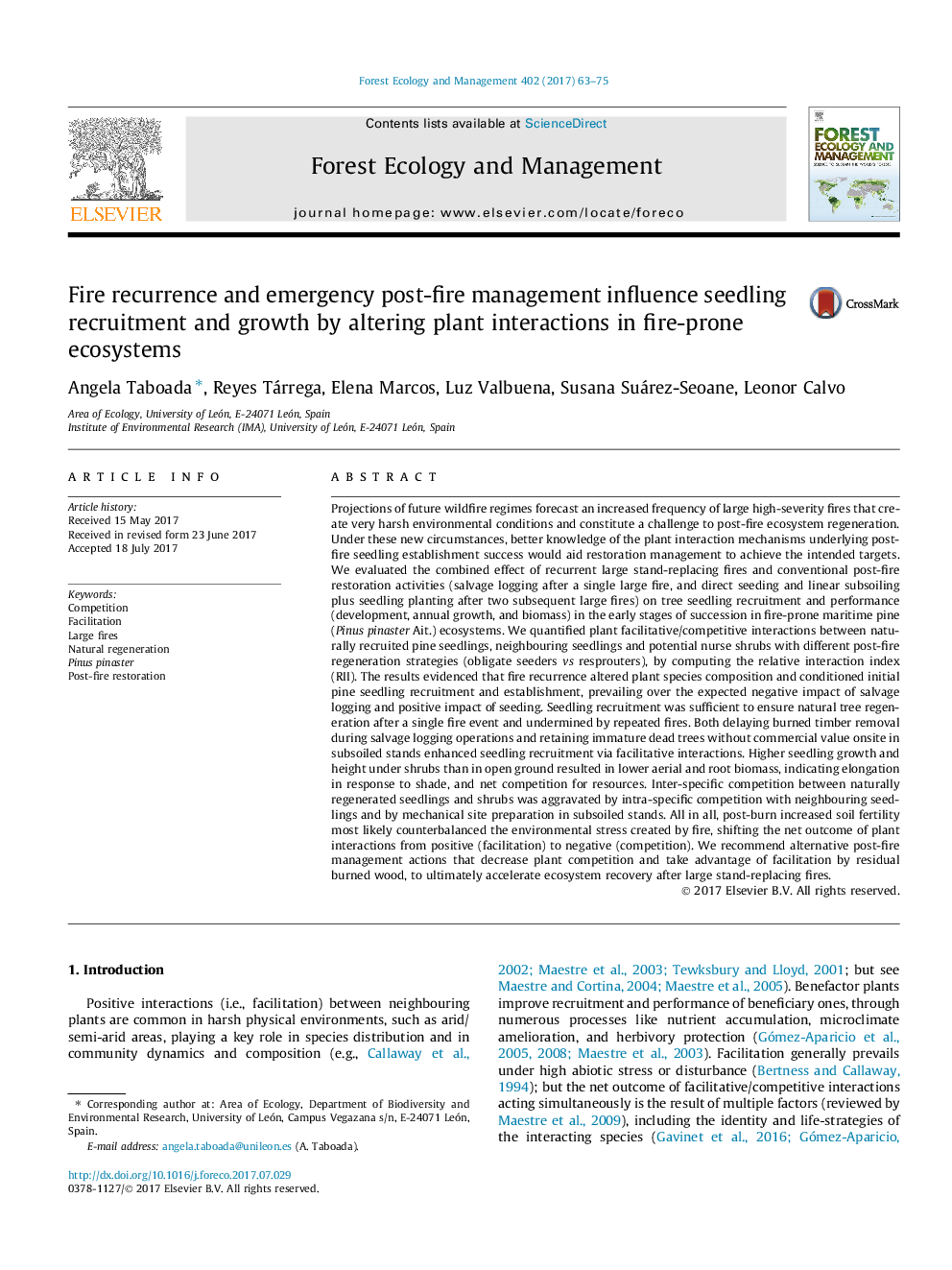| کد مقاله | کد نشریه | سال انتشار | مقاله انگلیسی | نسخه تمام متن |
|---|---|---|---|---|
| 4759341 | 1421356 | 2017 | 13 صفحه PDF | دانلود رایگان |
عنوان انگلیسی مقاله ISI
Fire recurrence and emergency post-fire management influence seedling recruitment and growth by altering plant interactions in fire-prone ecosystems
ترجمه فارسی عنوان
عود فاجعه و مدیریت اضطراری پس از آتش تأثیر پذیری و رشد گیاهچه را با تغییر تعاملات گیاهی در اکوسیستم های مقاوم در برابر آتش
دانلود مقاله + سفارش ترجمه
دانلود مقاله ISI انگلیسی
رایگان برای ایرانیان
کلمات کلیدی
موضوعات مرتبط
علوم زیستی و بیوفناوری
علوم کشاورزی و بیولوژیک
بوم شناسی، تکامل، رفتار و سامانه شناسی
چکیده انگلیسی
Projections of future wildfire regimes forecast an increased frequency of large high-severity fires that create very harsh environmental conditions and constitute a challenge to post-fire ecosystem regeneration. Under these new circumstances, better knowledge of the plant interaction mechanisms underlying post-fire seedling establishment success would aid restoration management to achieve the intended targets. We evaluated the combined effect of recurrent large stand-replacing fires and conventional post-fire restoration activities (salvage logging after a single large fire, and direct seeding and linear subsoiling plus seedling planting after two subsequent large fires) on tree seedling recruitment and performance (development, annual growth, and biomass) in the early stages of succession in fire-prone maritime pine (Pinus pinaster Ait.) ecosystems. We quantified plant facilitative/competitive interactions between naturally recruited pine seedlings, neighbouring seedlings and potential nurse shrubs with different post-fire regeneration strategies (obligate seeders vs resprouters), by computing the relative interaction index (RII). The results evidenced that fire recurrence altered plant species composition and conditioned initial pine seedling recruitment and establishment, prevailing over the expected negative impact of salvage logging and positive impact of seeding. Seedling recruitment was sufficient to ensure natural tree regeneration after a single fire event and undermined by repeated fires. Both delaying burned timber removal during salvage logging operations and retaining immature dead trees without commercial value onsite in subsoiled stands enhanced seedling recruitment via facilitative interactions. Higher seedling growth and height under shrubs than in open ground resulted in lower aerial and root biomass, indicating elongation in response to shade, and net competition for resources. Inter-specific competition between naturally regenerated seedlings and shrubs was aggravated by intra-specific competition with neighbouring seedlings and by mechanical site preparation in subsoiled stands. All in all, post-burn increased soil fertility most likely counterbalanced the environmental stress created by fire, shifting the net outcome of plant interactions from positive (facilitation) to negative (competition). We recommend alternative post-fire management actions that decrease plant competition and take advantage of facilitation by residual burned wood, to ultimately accelerate ecosystem recovery after large stand-replacing fires.
ناشر
Database: Elsevier - ScienceDirect (ساینس دایرکت)
Journal: Forest Ecology and Management - Volume 402, 15 October 2017, Pages 63-75
Journal: Forest Ecology and Management - Volume 402, 15 October 2017, Pages 63-75
نویسندگان
Angela Taboada, Reyes Tárrega, Elena Marcos, Luz Valbuena, Susana Suárez-Seoane, Leonor Calvo,
